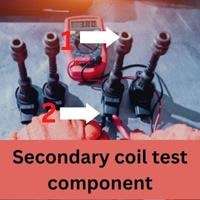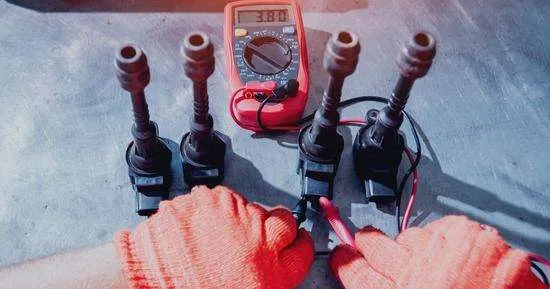Ford coil packs are ignition coils that work together to start your automobile. Because of its central role in the engine, the coil pack is particularly vulnerable to damage. When your Ford coil pack begins to malfunction, it’s usually a sign of worse problems. This post will teach you how to test a ford coil pack with a multimeter.
An ignition coil is an induction coil that transforms a battery’s low voltage to high voltage, which is used to generate a spark during ignition. An ignition coil converts 12 volts of battery power (typically 12 volts) into 50,000 volts (or more).
Primary and secondary coils work in such a way that the primary coil takes charge from the battery and magnifies it with the help of a large secondary coil, and then transfers it to the spark plug through windings.
Table of Contents
ToggleHow to test the ford coil pack with a multimeter
To test a magneto coil, we’ll measure resistance in the primary and secondary coil of the coil pack.
- Set your Multimeter to a resistance setting.
- Select a higher resistance range, such as 100K ohm, while testing the secondary coil and low resistance, such as 100 ohms, while testing the primary coil.
- Test the resistance of all terminals inside the primary coil plug ( coil wires connector).
- Also, test the resistance of the secondary coil(spark plug) with the plug terminals(primary coil).
- On the manual, compare all multimer readings with your coil pack model resistance ranges.
Follow a step-by-step guide below:
Precautions
- Disconnecting the battery is the first step.
- You can get shocked if you reach over to turn the engine on and touch the plug or coil pack.
- Glove your hands as much as possible throughout the operation.
Disconnect and Clean The Coil Pack
Find the ford coil pack by looking on or near the engine. It’s time to take the ignition coils off of their mounting brackets. There are wires on both sides of the ford coil pack.
If the coil is unclean or rusted, the tets will be more time-consuming and inaccurate. Dust can get into the ignition coil’s ports and cause the little parts to malfunction, so keeping them clean is essential.
Inspect The Primary Coil Pack
First, visually inspect for any damage, as engine heat can make the plastic coils break down and leak the spark.
There are two kinds of coils in a standard Ford coil pack: the primary and auxiliary. Power is transmitted directly from the battery to the primary winding, composed of thick wire.
If you haven’t already, check the main coil pack, which has three ports on the main connector. Connect the wires from each spark plug terminal to a coil using the Multimeter’s probes and check the resistance using the Multimeter’s leads.
Set your Multimeter
Insert the red probe into the VmAΩ port and the black probe into the COM port.
Set your Multimeter to resistance setting by rotating the knob to the Ω sign and select 200 ohms in the primary test and 100K ohms in the secondary coil test.
Primary Coil Test
There are two coils in a coil pack that we have to test. The first one is the primary coil. To test the primary coil, we have to test the resistance of the two terminals in the coil pack plug attached to the connector. Different car models can have 2 or three terminals in the primary coil.
Set up your Multimeter to ohms with a low range, as the primary coil has very little resistance.
Connect both probes to each terminal inside the plug. You can connect probes in any direction to the terminals, as resistance is non-directional.
Resistance in primary coil terminals should be around 1 ohm. If your coil pack has three terminals, test all the terminals with each other, and resistance should be equal in each terminal.
Secondary coil test
Now it’s time to test the secondary coil. You can test the sensory or spark plug while the ignition coil pack is attached or removed from the vehicle. For this, we’ll test the primary coil terminals with the spark plug.
Connect one probe to a terminal in the coil pack plug and the other probe to the spark plug inside the rubber casing. Your Multimeter should read between 10-20k ohms in the secondary coil.
Remove a wire from the coil pack when the ignition coil is mounted in the engine. Connect the spark plug to the terminal (from where the wire was removed). Ground your spark plug with an extended wire by connecting one end to the spark plug and the other to the battery. Now, if you start the engine, you’ll see the spark in the plug while the vehicle is cranking.
Signs of bad ignition coils
Poor ignition coils will make the engine lose its power and fuel economy, causing stalling misfires and low-voltage sparks in the plug. There are two ways the coils fail: completely, as in no output, or intermittently, as sometimes the coil works and sometimes it does not.
This can happen for various reasons, including improper installation, vibration, overheating, and damaged insulation. In many cases, especially with 4-cylinder vehicles, a malfunctioning ignition coil will prevent the engine from starting. However, this component is crucial since it supplies power to the ignition coil, keeping your engine operational.
Conclusion
Sometimes it’s hard to tell if the problem is with the coils or the ignition system. Multimeter makes it easy to analyze a ford coil pack by checking the resistance in ignition coil parts.
Compare the resistance of the Multimeter with the ideal range of your ignition coil model. Check the manual for readings and testing points.
Related Guides:






